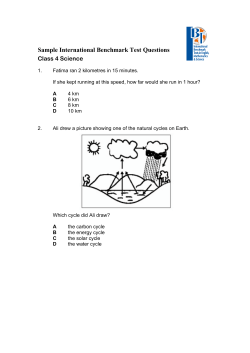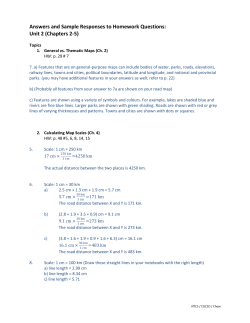
Geologic column Nalin v4
The Geologic Column Organizing the Layers of Earth’s Crust Permian Supposed 6 My unconformity Supposed 14 My unconformity Pennsylvanian Lines indicate horizontal layers Mississippian Devonian Cambrian Check it out yourself! Collect several different “sediments”: playground sand, beach sand, diatomaceous earth, powdered clay, garden soil, aquarium gravel, etc... Find a clear, 16-20 oz cup. Fill it to a little less than 1/2 full with water. Choose one of the sediments and gently sprinkle 2 spoonfuls of sediment over the surface of the water. Wait until the sediment settles to the bottom, Then repeat this step with different “sediments” until you have several layers at the bottom of your cup. Which layer is the oldest? Which is the youngest? In the Grand Canyon, some of the lower layers contain trilobites. Higher up, a variety of fossil brachiopods, corals and mollusks are found. Near the top, some layers contain footprints of small vertebrates. Fossil Trackways Many trackways are found in the Grand Canyon. The Coconino Sandstone has tracks from many different animals. Brachiopods These marine organisms have two valves (shells, like clams) and are very common in some layers of the geologic column. The diversity between species allows geologists to use them for identification. Trilobites These ancient arthropods are not found living today. Their variety of traits are unique enough to allow geologists to use trilobites to identify where the layer they are studying lies within the geologic column. Leonard Brand Quaternary Cenozoic By combining information from the position of rock layers and the vertical distribution of fossils within them, it is possible to build a framework in which layers from one locality can be placed relative to layers in other places (a method called correlation). This framework is called the geologic column. Neogene Paleogene Cretaceous Mesozoic Look at the above picture of the Grand Canyon. There are numerous layers stacked on top of each other. Which layers were laid down first? Sedimentary layers often contain fossils, which are remnants of organisms that lived in the past. Fossils are not randomly distributed. Each type is found in only certain layers and not others. The order in which fossil types appear and disappear in the sequence of sedimentary layers seems consistent between different places on Earth’s surface. 4) Gaps in the Column Jurassic Triassic Permian Pennsylvanian The geologic column is divided Mississippian into intervals, each with its Devonian assigned name. Major intervals like the Paleozoic, called Erathems1, are Silurian divided into subintervals called Ordovician 2 systems and these are further Cambrian subdivided into series3.To be placed Precambrian within a certain interval, a layer must meet the criteria on which that interval is defined (e.g., correct fossil content, correct position relative to other layers). Based on those features, most of the layers of the Grand Canyon have been assigned to the Paleozoic interval of the geologic column. Paleozoic In a sequence of sedimentary layers, the layers at the bottom were generally laid down before those at the top. 3) The Geologic Column 2) Order in the Fossils Phanerozoic 1) Order in a Sequence of Layers (1) also called Eras (2) also called Periods (3) also called Epochs Supposed 100 My unconformity Entire intervals of the geologic column can be missing from the sequence of layers in a certain area. Where layers are missing, the gap in the geologic column is called an unconformity. In the Grand Canyon, several very flat unconformities have been identified. According to the most common interpretation of the geologic column, these gaps represent millions of years. However, others find this interpretation unpersuasive. One reason for this is it seems unreasonable to suppose that a surface could remain for millions of years with no erosion. The Illawara paraconformity from Australia. The standard explanation suggests there is a gap of several million years between the coal seam (black) and the overlying layers. But the contact is flat and has no signs of erosion. Questions for reflection 1) Is it possible to determine the sequence of layers in the geologic column even without knowing the absolute age of the rocks? 2) One interpretation of the flat unconformities in the Grand Canyon is that they represent gaps due to erosion or no deposition for millions of years. What could be some problems with this interpretation? ©2014
© Copyright 2025









